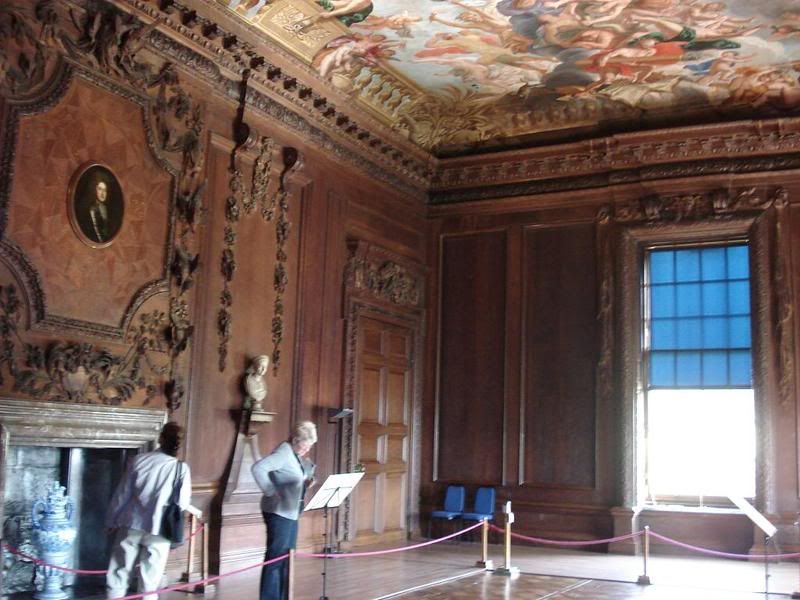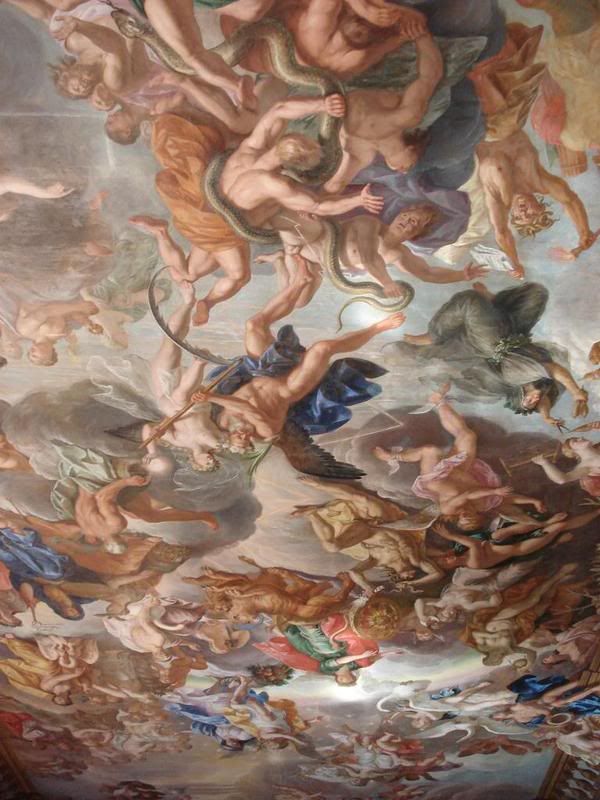
Running along the top floor of the south side of the house is the State Rooms. These five apartments were built with the intention of housing a visiting monarch. Indeed, much care went into these lavish rooms in anticipation of the monarch's arrival, by varying dukes through time. All were disappointed, and the apartments wasted for their purpose until Queen Victoria finally fulfilled the rooms' purpose in 1843. By the early 19th century the baroque State Rooms were
 out of style, and Georgiana's son, Hart found them rather ghastly and a waste of a great view. However, he suspected they could be "a museum for old furniture and a walk in bad weather" so the rooms were spared on his premonition. And thank goodness for that! Today they stand as some of the finest examples of baroque interiors in all of England. The next few entries on Chatsworth will be devoted to these apartments.
out of style, and Georgiana's son, Hart found them rather ghastly and a waste of a great view. However, he suspected they could be "a museum for old furniture and a walk in bad weather" so the rooms were spared on his premonition. And thank goodness for that! Today they stand as some of the finest examples of baroque interiors in all of England. The next few entries on Chatsworth will be devoted to these apartments.
The first room guests will happen upon is the State Dining Room. Under 11 foot high doorways they enter into a vast array of wood paneling. Rich reliefs protrude from the wood panels depicting intricate garlands. These garlands consist of wild plants and freshly killed fowl and shellfish; hunting spoils. Yes, I know, decorating your house with dead animals may not be your personal taste but the carving is absolutely exquisite. It reminded me of the themed carvings in and on Amsterdam's Town Hall, one of my favorite buildings in the world. At the end of the room is a massive floor-length mirror which is so clear you feel like Alice entering the looking glass.
 The ceiling mural by Verrio is, once again, breath-taking. This shows the Greek gods proclaiming the Golden Age because William and Mary have been named the rulers of England. The first Duke was a big fan of William, and designed these rooms with every intention of William staying there, which of course, he did not. His housekeeper, Mrs. Hackett got in one too many arguments with Verrio and is immortalized in this mural as the haggard fate snipping the threat of life. This is framed with a trompe l'oeil banister so it appears you are looking through the roof into the sky.
The ceiling mural by Verrio is, once again, breath-taking. This shows the Greek gods proclaiming the Golden Age because William and Mary have been named the rulers of England. The first Duke was a big fan of William, and designed these rooms with every intention of William staying there, which of course, he did not. His housekeeper, Mrs. Hackett got in one too many arguments with Verrio and is immortalized in this mural as the haggard fate snipping the threat of life. This is framed with a trompe l'oeil banister so it appears you are looking through the roof into the sky.Despite King William declining his biggest fan's hospitality, the dinging room, or Great Chamber as it was known until the Victorian age, would be used as a gathering place for guests in the grandest of occasions. There can be no question why. You can spends hours circumnavigating the room and still notice something new every time.
The cross-section above is by Nick McCann

Fabulous, fabulous post. Thank you for sharing.
ReplyDelete